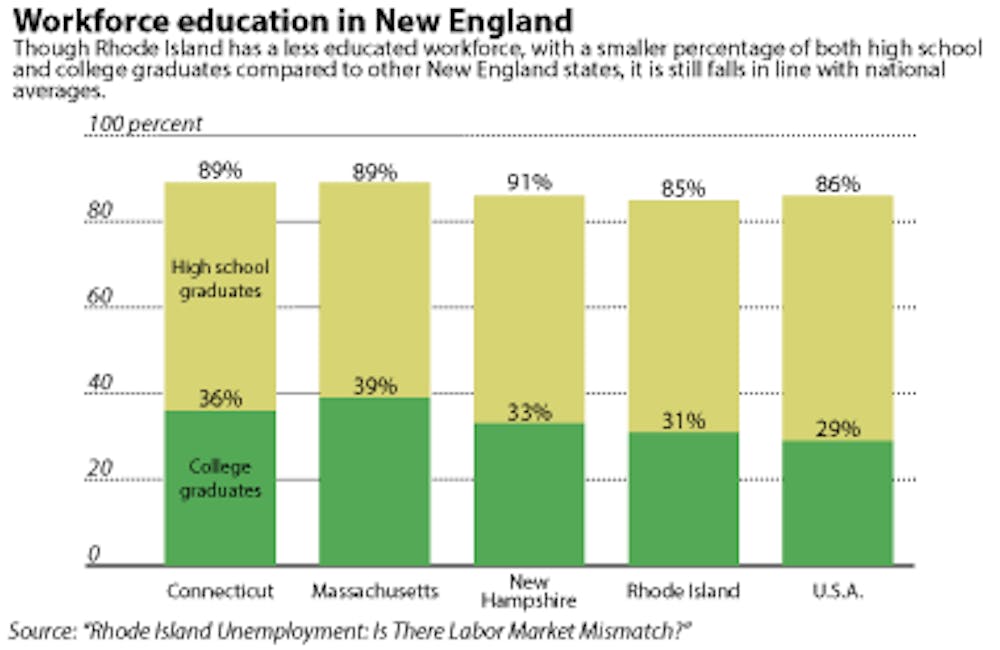Rhode Island continues to have one of the highest unemployment rates in the nation as a result of education levels, household wealth and extension of unemployment benefits, according to a recent report by the College and Research University Collaborative of Rhode Island.
The Collaborative released its second in a series of three reports focused on the state’s workforce, infrastructure, manufacturing and regional competitiveness March 22.
The report, titled “Rhode Island Unemployment: Is There Labor Market Mismatch?” was written by Assistant Professor of Economics Neil Mehrotra and explores the factors behind the state’s high unemployment rate following the 2009 recession in comparison to other New England states.
The report examines the “Beveridge curve,” a model that describes the “change in the relationship (between) job openings and unemployment,” Mehrotra said, adding that his own research focuses on shifts in the Beveridge curve.
An organization called Footnote, founded by Joseph Morone ’04, Diana Brazzell ’04.5 and Jon Warman ’05, works with the Collaborative to “translate” academic research into layman’s terms and help policymakers contexutalize the meaning of the research, Morone said. Footnote compiled the report presented to the Statehouse, though Mehrotra wrote the original study.
The drop in construction industry employment and the recession’s particularly large impact on new businesses, which typically grow and hire at a faster rate, could contribute to the high job opening rate but low employment rate after the 2009 recession.
A drop in construction industry employment could result in “labor market mismatch” — a term referring to when workers from a waning industry lack the skills required to transition to a growing industry, according to the report.
But “while labor market mismatch may play a part, it does not appear to be the dominant factor explaining why Rhode Island’s unemployment rate has been so much higher than the rest of the country,” Mehrotra wrote in the report.
A lower proportion of the Rhode Island workforce is composed of high school and college graduates in comparison to the workforces of neighboring states, according to the report. But this only partially explains the state’s high rate of unemployment, since its education rates fall near the national average.
Another reason for the particularly quick rise in unemployment in Rhode Island is the “decline in housing wealth,” which “was responsible for nearly half the national increase in unemployment during the Great Recession,” Mehrotra wrote.
Most households’ “wealth is tied up in the value of their real estate,” Mehrotra said.
The recession’s effects on household wealth were greater in Rhode Island than in neighboring states, which “could plausibly account for the more severe rise in unemployment experienced in Rhode Island compared to its neighbors,” Mehrotra wrote.
Studies on the same topic have also suggested that extended unemployment benefits are linked to higher unemployment rates, Mehrotra said.
“At the end of 2012 … Rhode Island offered 99 weeks (nearly 2 years) of unemployment benefits, while Massachusetts and New Hampshire provided only 40 weeks,” the report states.
When the benefits expired at the end of last year, unemployment in the state dropped by two percentage points, which is a “pretty fast drop,” Mehrotra said, adding that it was “not as if everyone got jobs — they just dropped out of the work force” and are no longer counted as being unemployed.
Spending more on infrastructure, which in turn increases the number of construction jobs is one way to help the state come back from the recession, Mehrotra said, adding that doing so has the “dual benefit” of increasing the state’s competitiveness and boosting demand.
“In the long run, the bigger problem is Rhode Island isn’t growing that quickly,” Mehrotra said, adding that policies that could be adopted include increasing the work force’s education and improving the state climate for businesses relocation and expansion.
Mehrotra’s report, along with two other reports released by the Collaborative this year, was presented to members of the Statehouse March 24.
The Collaborative is a nonprofit organization that began two years ago when the Rhode Island Foundation hosted an event called “Make It Happen,” said Amber Caulkins, program director for the Collaborative. The group’s goal is to bring together the state’s 11 colleges and universities to provide non-partisan, evidence-based research for state policymakers.
The organization is overseen by the Association of Independent Colleges and Universities and receives funding from the state, R.I. Foundation and the institutions part of the Collaborative, Caulkins said.





